1. Overview
The importance of a good research question cannot be overstated in the research process. A well-crafted research question is the cornerstone of a successful research endeavor, guiding researchers toward valuable insights and impactful outcomes.
The tutorial explores the significance of a good research question, emphasizing its role in refining the scope and aligning research objectives. It discusses key criteria such as clarity, feasibility, relevance, and significance that distinguish strong research questions. Practical tips and strategies are provided to aid researchers in formulating precise and answerable research questions.
2. Research Problem
A research problem refers to the specific issue or topic a researcher wants to investigate and study. It’s the question or issue that the researcher wants to explore, analyze, and ultimately answer through their research. The research problem should be a clear and concise statement outlining the gap or knowledge deficit in the current research and identifying the specific research questions to address. A well-defined research problem is crucial for producing meaningful and valuable research outcomes.
2.1. General Area of Interest
A general idea of the research topic is essential because it provides a starting point for further research and helps focus the research problem. It also helps to ensure that the research topic is relevant and interesting to the researcher and the field of study.
A general idea can be based on personal interests or previous experiences or inspired by current events or emerging trends in the field. Once a general area of interest has been identified, the researcher can conduct a literature review to identify gaps in the existing research and narrow down the research problem.
2.2. Literature Review
A literature review is essential for research as it helps identify gaps in existing knowledge, guiding the formulation of research questions. It ensures originality by avoiding duplication of previous work. Additionally, it informs the research design, ensuring appropriate methods and techniques are employed. By integrating existing literature, researchers strengthen the credibility of their work and provide valuable evidence to support their findings. Overall, a thorough literature review enhances the quality and validity of research.
3. Research Question
The research question guides the study and is specific, focused, and answerable. The research question is typically derived from the research problem and helps narrow the study. It provides a clear and concise direction for the research and helps ensure the study is relevant and feasible.
The research question should be specific and answerable and avoid being too broad or too narrow. It should be designed to provide insight into the research problem and address the research gap identified in the literature review:
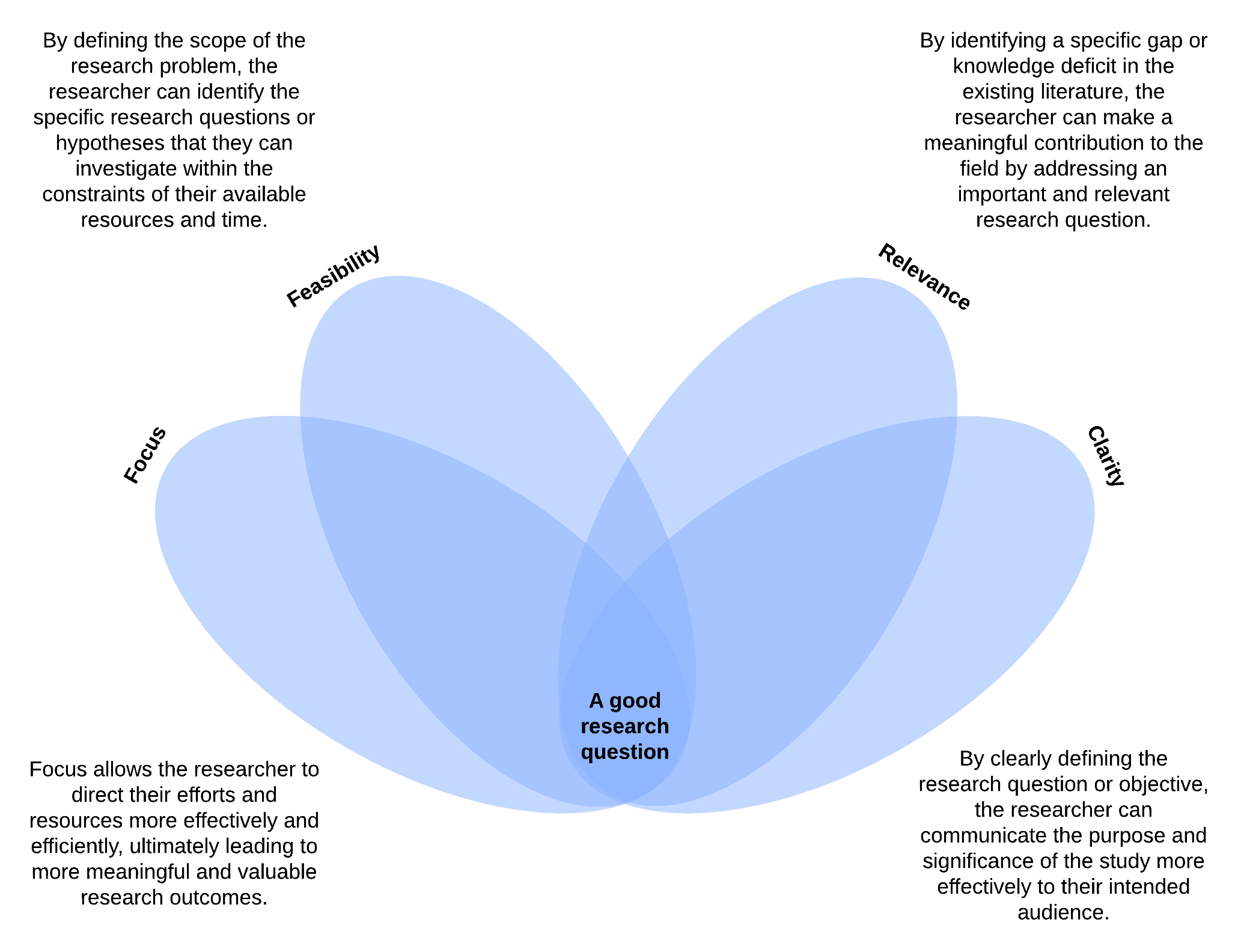
4. Narrowing Down Frameworks
Several frameworks and approaches can help to narrow down a research problem.
4.1. PICO
The PICO framework is often used in healthcare and medical research to formulate focused research questions. It involves identifying the specific population or patient group, the intervention or treatment being considered, the comparison group or alternative intervention, and the desired outcome.
PICO Component
Abstract Component Inherent to All Research Designs
Problem
Research object
Intervention
Application of a theory or method
Comparison
Alternative theories or methods (or, in their absence)
Outcome
Knowledge generation
Although the PICO framework is mainly used in healthcare and medical research, it’s possible to tweak this technique to apply to any research area and type:
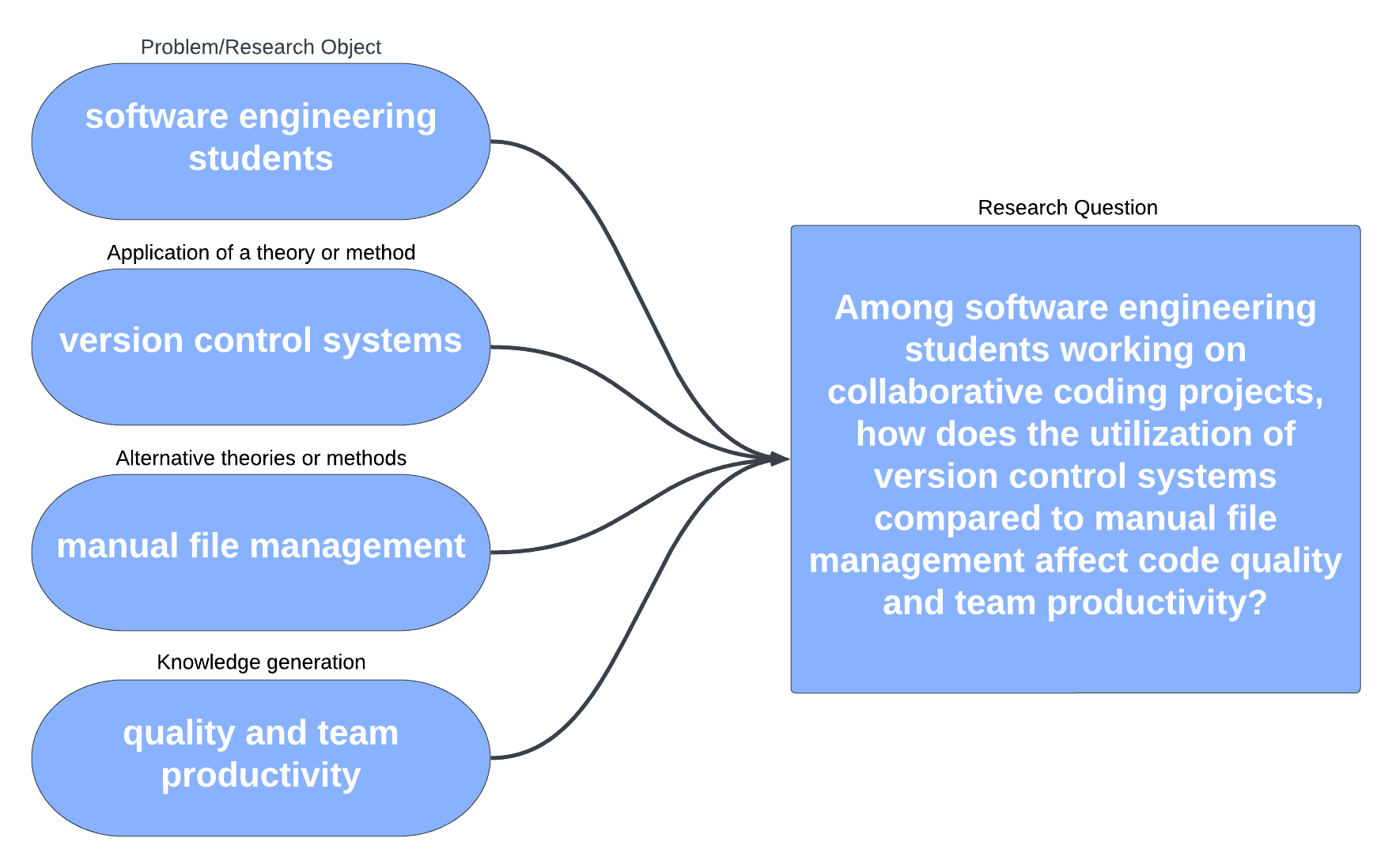
This research question directs the investigation into assessing the influence of version control systems on code quality and team productivity in the context of collaborative coding projects among software engineering students. By comparing the use of version control systems with manual file management, researchers can analyze the potential benefits of code quality and team productivity achieved through adopting proper version control practices.
4.2. FINER
The FINER technique is a tool that researchers should consider when evaluating and refining their research questions:
- Feasible: A research question should be feasible, considering available resources, time constraints, and access to data or participants
- Interesting: An interesting research question captures the researcher’s and the wider academic community’s attention and curiosity
- Novel: A research question should exhibit novelty by exploring new perspectives, approaches, or methodologies
- Ethical: Ethics play a critical role in research, and a research question should align with ethical considerations and guidelines. Researchers must ensure their study prioritizes participants’ well-being, privacy, and rights
- Relevant: Relevance is an essential criterion for a research question, ensuring that the study addresses real-world problems or contributes to advancements in theory or practice
Researchers can critically evaluate and refine their research questions using the FINER technique to ensure feasibility, interestingness, novelty, ethical integrity, and relevance. This evaluation process enhances the quality and impact of the research, leading to more focused and purposeful studies:
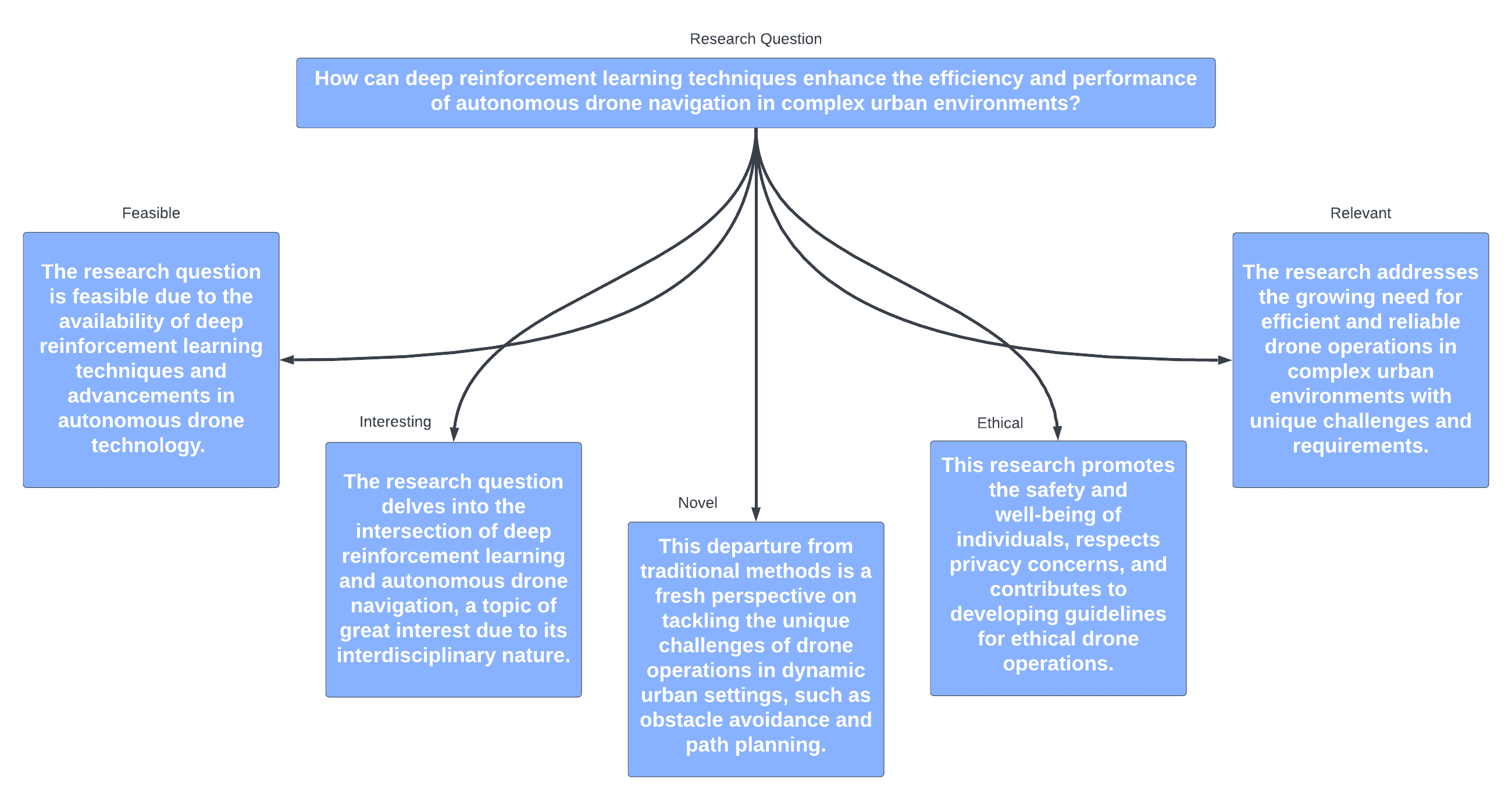
The FINER technique serves as a guide for conducting research that explores the application of deep reinforcement learning in improving autonomous drone navigation while ensuring ethical integrity and addressing real-world challenges.
4.3. SPICE
The SPICE framework is commonly used in social sciences and qualitative research. It helps researchers narrow down the research problem by considering specific elements. Setting refers to the context or environment of the research. Perspective involves identifying the viewpoints or perspectives of the individuals involved. Intervention refers to the actions or changes being studied. Comparison is the alternative or control group, and evaluation refers to the desired outcome or impact.
The framework guides users through five components:
- Setting – where?
- Perspective – for whom?
- Intervention – what?
- Comparison – compared with what?
- Evaluation – with what result?
Although this technique is mainly used for social sciences, to some extent, it can be applied to any field:
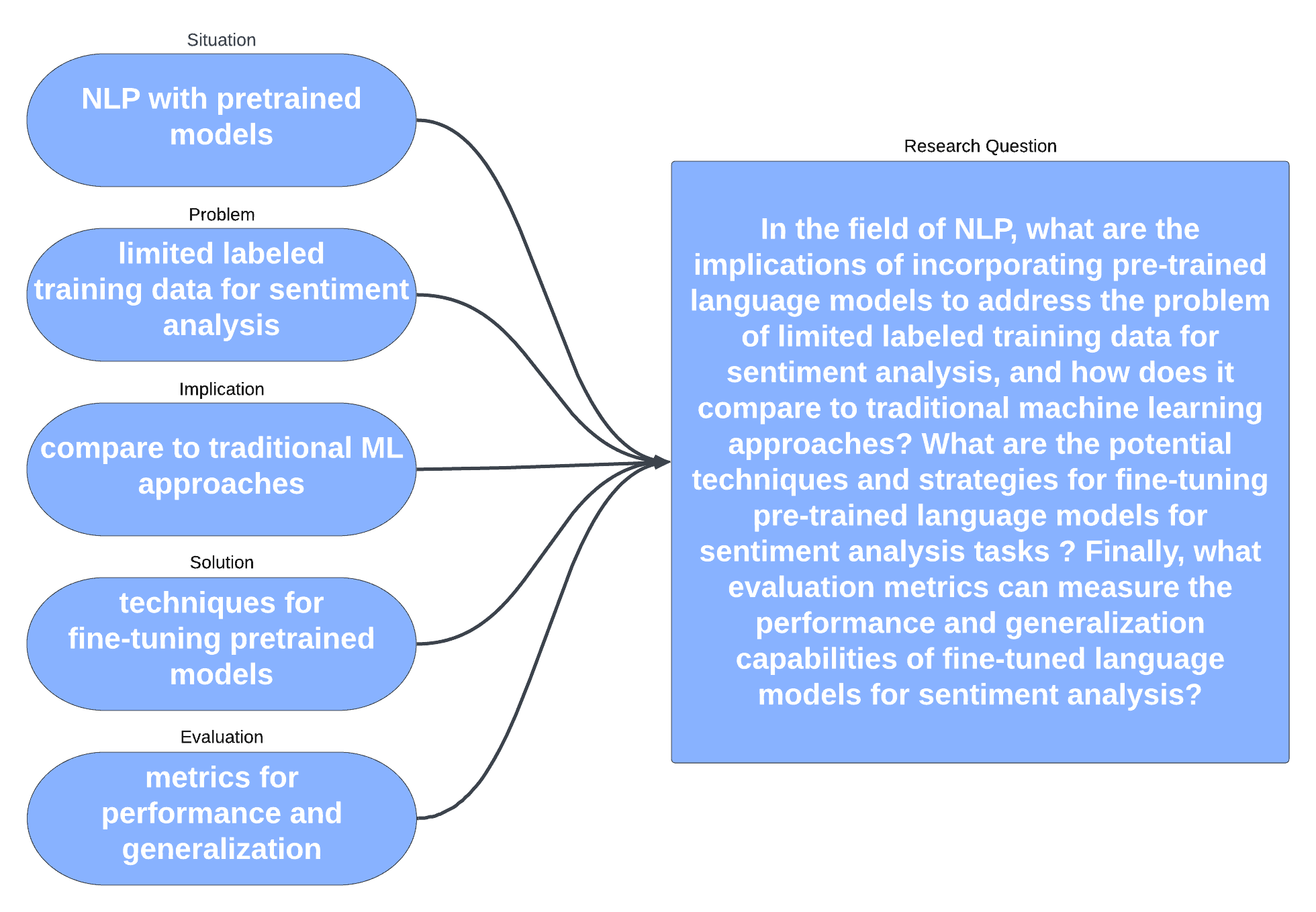
Using the SPICE, this research question guides the investigation into examining the implications, comparison, techniques, and evaluation of incorporating pre-trained language models for sentiment analysis in natural language processing. It aims to address the challenge of limited labeled data and explore the effectiveness of pre-trained models in sentiment analysis tasks.
4.4. Gap Analysis
This framework requires a thorough review of the existing literature and identifying gaps or knowledge deficits in the field. By critically analyzing previous studies and identifying areas that haven’t been adequately addressed or require further exploration, researchers can narrow down the research problem and focus on addressing these gaps. Gap analysis helps ensure the research problem is relevant and contributes to the existing body of knowledge.
Using gap analysis tables might provide structure to this approach:
Existing Research
Identified Gap
Research Question
Previous studies have explored various machine learning algorithms for sentiment analysis in social media data.
Limited research exists on using deep learning techniques, such as recurrent neural networks (RNNs), for sentiment analysis in social media.
How does the application of recurrent neural networks (RNNs) enhance the accuracy and performance of sentiment analysis in social media data?
Existing research has predominantly focused on English language sentiment analysis.
Limited research exists on sentiment analysis in other languages, such as Arabic or Chinese, in the context of social media.
What are the challenges and opportunities in performing sentiment analysis on non-English social media data, specifically in languages like Arabic or Chinese?
Previous studies have primarily used text-based features for sentiment analysis in social media.
Limited research exists on incorporating multimodal features, such as images or emojis, in social media data sentiment analysis.
How can integrating multimodal features, including images and emojis, improve the accuracy and depth of sentiment analysis in social media data?
It’s possible to get a hint about a research gap and the direction from the recommendations for future research sections in available research.
4.5. The Problem-Solution Framework
A Problem-Solution Framework is used in research and problem-solving processes to identify, analyze, and address specific problems or challenges. It involves structuring research questions and investigations around well-defined problems and proposing potential solutions or approaches to address them.
In this framework, the focus is on understanding and defining the problem clearly. This includes identifying the underlying causes, contextual factors, and implications of the problem within the specific domain of study. Researchers then explore and evaluate potential solutions or strategies to mitigate or resolve the identified problem.
The Problem-Solution Framework typically involves several stages:
- Clearly define the problem or challenge that needs to be addressed. This includes understanding the context, examining existing research and literature, and identifying the gaps or issues that require attention.
- Analyze the problem in-depth, examining its root causes, impact, and potential consequences. This involves gathering relevant data, conducting experiments or simulations, and considering different perspectives to understand the problem comprehensively.
- Brainstorm and explore potential solutions or approaches to address the problem. This involves considering strategies, methodologies, algorithms, or technologies that may provide viable solutions. Researchers assess the feasibility, advantages, and limitations of each proposed solution.
- Evaluate the proposed solutions based on specific criteria or metrics. This may involve conducting experiments, simulations, or performance evaluations to measure each solution approach’s effectiveness, efficiency, scalability, or user satisfaction. Researchers analyze the results to determine the most suitable solution or combination.
- Implement the chosen solution and validate its effectiveness in real-world scenarios. This step involves deploying the solution, monitoring its performance, collecting data, and analyzing the outcomes to assess its success in addressing the identified problem.
All the stages contribute to the research question and can be used to refine and narrow it down:

4.6. The Context-Action-Result (CAR) Framework
The Context-Action-Result (CAR) Framework analyzes and understands complex situations, actions, and outcomes within a specific context. It helps researchers structure their investigations by considering the contextual factors, the actions or interventions taken, and the resulting outcomes or impact.
The CAR Framework involves the following elements:
- The Context step focuses on understanding the specific context or environment in which the research is conducted. It includes the background information, circumstances, constraints, and relevant factors that shape the situation under study. Contextual factors can include social, cultural, economic, technological, or organizational aspects influencing the research problem.
- The Action element refers to the specific actions, interventions, or methodologies undertaken by the researcher to address the problem or achieve a desired outcome. It involves implementing specific strategies, techniques, or approaches to bring about change or make an impact.
- The Result stage encompasses the outcomes, consequences, or effects of the actions or interventions taken. It involves analyzing and evaluating the results of the research or intervention based on specific criteria or metrics. Results can be tangible or intangible, direct or indirect, and may have short-term or long-term implications.
The CAR Framework differs from the previous ones because it has a clear direction and temporal dependencies between steps:
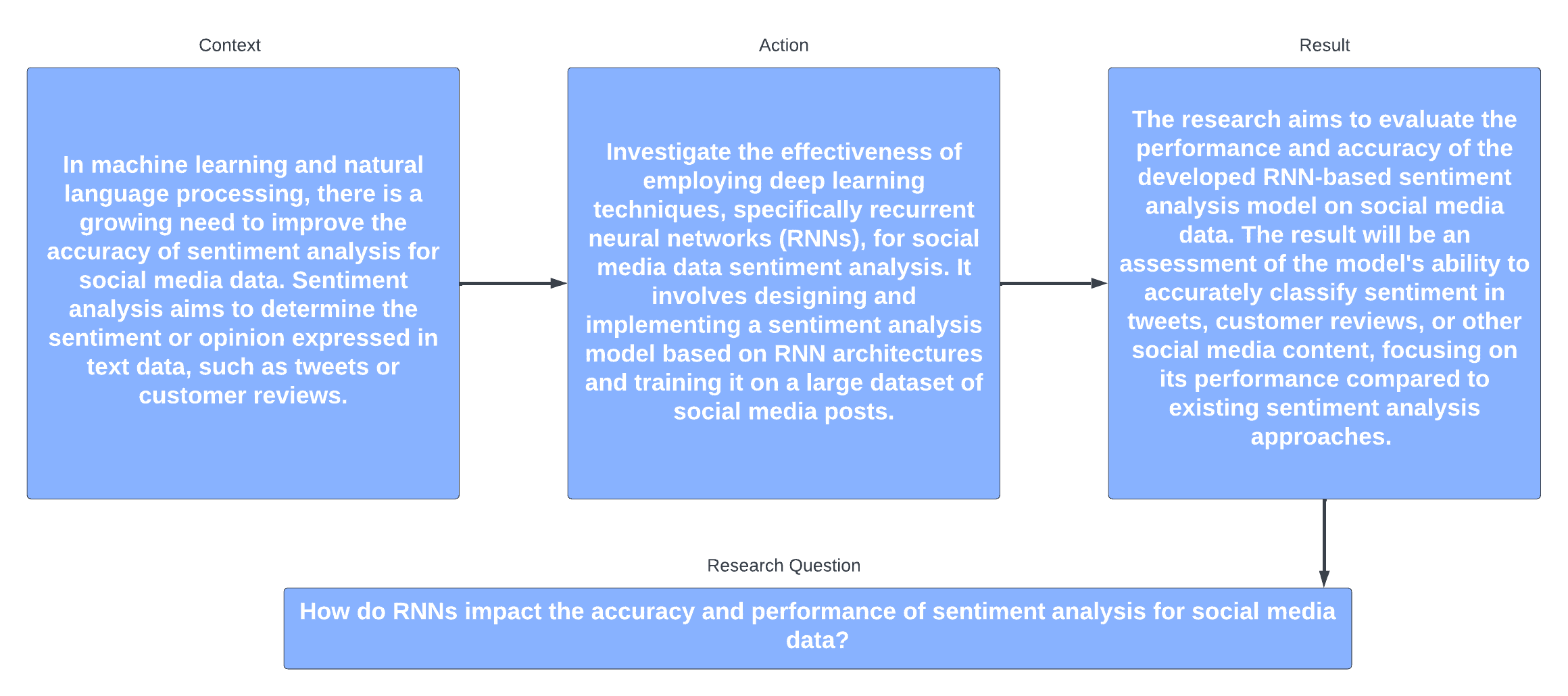
4.7. So What?
The “So what” technique is a helpful approach in narrowing down a research question. Also, it helps to validate a research question and ensure its significance and impact.
By employing the “So what” technique, researchers can critically evaluate the potential significance of their research question. It helps them refine and narrow down the question by emphasizing the need for a clear purpose, meaningful outcomes, and potential benefits to the field of study or broader society.
When using the “So what” technique, researchers should consider the following:
- How will answering this research question contribute to practical knowledge, inform decision-making, or address real-world challenges?
- What new insights or theoretical perspectives will be gained by investigating this research question? Does it challenge existing theories or expand current understanding in the field?
- Is the research question timely and relevant to current issues, debates, or trends in the field? Does it address an important gap or knowledge deficit?
- What are the potential implications or benefits may arise from answering the research question? How might the findings influence policy, practice, or future research?
By incorporating the “So what” technique, researchers can ensure that their research question holds significance and contributes to the broader body of knowledge. It helps refine the question and align it with the larger goals and impact of the research study:
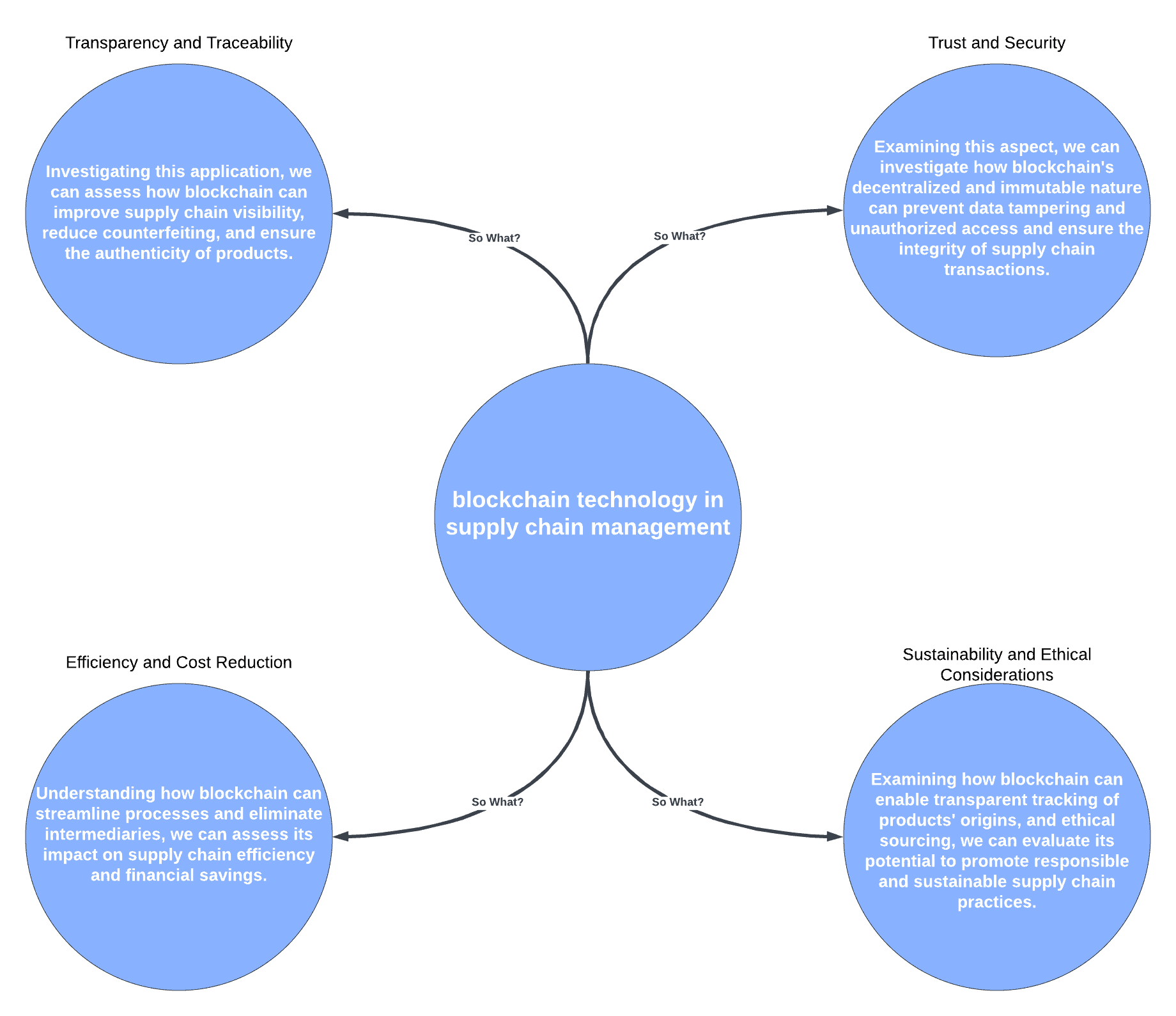
5. Tips for Narrowing Down Research Questions
Here are some general tips for narrowing down research questions:
- Consider the research problem and gap identified in the literature review
- Identify key concepts related to the research problem and use them to narrow down the research question
- Use specific language in the research question to clearly define the scope and focus of the study
- Avoid using vague terms in the research question
- Test the research question to ensure it’s feasible, relevant, and clear
6. Conclusion
In summary, narrowing down a research problem and formulating a good research question are crucial in the research process. A well-crafted research question provides a clear direction and purpose, guiding researchers toward valuable insights and impactful outcomes. Conducting a literature review helps identify gaps in existing research, avoid duplication of efforts, and support arguments with existing evidence.
Various frameworks and techniques can aid in narrowing down the research problem and formulating precise research questions. Key considerations include relevance, feasibility, clarity, and significance of the research question. By following these guidelines, researchers can enhance the quality and impact of their research, contributing to the advancement of knowledge in their respective fields. A strong research question is a foundation for a successful research study, making valuable contributions to the academic and practical spheres.